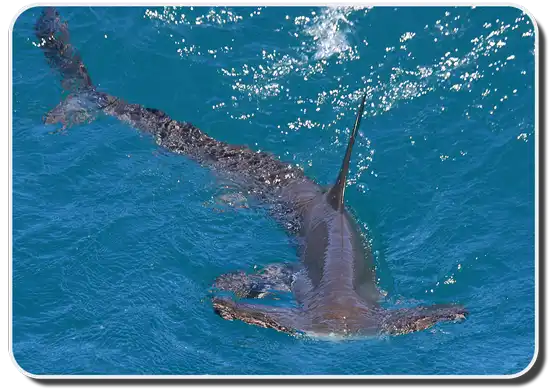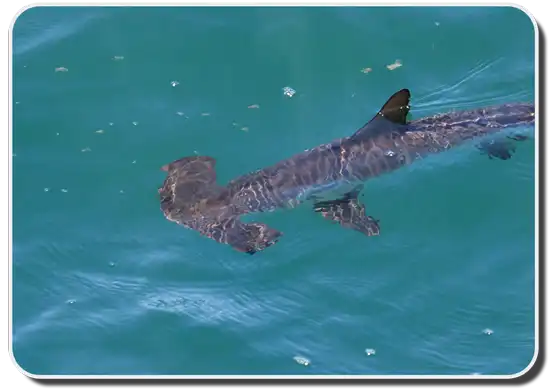The smooth hammerhead is the second largest hammerhead, after the great hammerhead. It is named after its cephalofoil, which has no indentations and a smooth texture.

Smooth Hammerhead Scientific Classification |
|
| Kingdom | Animalia |
| Phylum | Chordata |
| Class | Chondrichthyes |
| Order | Carcharhiniformes |
| Family | Sphyrnidae |
| Genus | Sphyrna |
| Scientific Name | S. zygaena |
Description
Smooth hammerheads are generally 8.2–11.5 ft long, with the record held by a 16 ft specimen. The maximum weight of one of these sharks has been recorded to be 880 lb.
Compared to other large hammerheads, these sharks’ cephalofoils – or “hammerheads” – are curved with no indentation. The cephalofoils are short but wide, around 26–29% of the shark’s total body length.
Inside the mouth of this shark, there are 26–32 tooth rows in the upper jaw and 25–30 in the lower one, with each tooth being triangular and varying from smooth or serrated.
Their bodies are streamlined. The first dorsal fin is falcate and tall, with a rounded tip and the pectoral and pelvic fins have nearly straight rear margins. The anal fin is more significant than the second dorsal fin, with a tall free rear edge and a notch in the hind margin.
They are dark brownish gray to olive from above and white from below.
Where do they live
Map Of The Smooth Hammerhead Shark’s Habitat

These sharks have a wide range, living in the world’s three major oceans. They are distributed throughout the Atlantic from Nova Scotia to the Virgin Islands, ranging throughout Brazil to south Argentina in the west and the British Isles to Côte d’Ivoire in the east. In the Indian Ocean, the smooth hammerhead has been spotted throughout India, Sri Lanka, and South Africa, and in the Pacific, they occur in Australia, California, Chile, Ecuador, the Galapagos Islands, the Gulf of Tonkin, the Hawaiian Islands, Panama, the Russian Far East, and southern Japan.
Smooth hammerheads tend to stay close to the surface at around depths of 66 ft, though reports indicate they dive as low as 660 ft. It prefers coastal waters such as bays and estuaries. It is sometimes seen in the open ocean at places over the continental shelf, around oceanic islands, and even in freshwater habitats.
Behavior
Hunting
Opportunistic by nature when it comes to feeding, these sharks both hunt a wide variety of prey but will not hesitate to scavenge from fishing lines. Their diet includes bony fishes like herring, menhaden, pilchard, seabass, Spanish mackerel, cephalopods, crustaceans, rays, and sharks, even those of its species. Though rare, these sharks may go after dolphins if the opportunity arises.
Migratory
In the summer, smooth hammerheads migrate towards the poles, swimming just below the surface to stay in cooler water while heading back towards the equator in winter. Adults are either solitary or form small groups but will come together in great numbers during their yearly migrations. Schools of over a hundred juveniles have been observed off the eastern Cape of South Africa, while groups thousands strong have been reported in California.
 Reproductive
Reproductive
Similar to other hammerhead sharks, the smooth hammerhead gives live birth to a large litter of 20-50 pups after close to a year of gestation. The females tend to go into labor in shallow coastal nurseries. Initially, these sharks are 20–24 in long, with males reaching sexual maturity at 6.9–8.2 ft while females do so at 8.9 ft.
On average, the smooth hammerhead lives for around 20 years.
Adaptations
Like other hammerheads, the cephalofoil of these sharks helps them maneuver around while detecting electrical fields generated by prey.
Interactions with humans
 Due to its size, the smooth hammerhead is potentially dangerous to humans, with 34 attacks attributed to it. Seventeen of these attacks were unprovoked, one being fatal. However, most of these attacks are unconfirmed.
Due to its size, the smooth hammerhead is potentially dangerous to humans, with 34 attacks attributed to it. Seventeen of these attacks were unprovoked, one being fatal. However, most of these attacks are unconfirmed.
This shark has been targeted for both its meat and its liver oil. It is also sometimes captured as bycatch and by recreational anglers. The IUCN classified this shark as “Vulnerable” or “VU” for these reasons.
